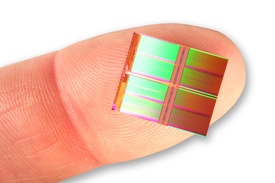Intel and Micron say they’ve started mass production of the world’s first 20 nm, 128GB, multi-level cell flash memory storage device. I’d expect the iPad 3, which should arrive sometime next spring, to have a 128GB hard drive. Perhaps the iPhone 5, as well.
Developed through Intel and Micron’s joint-development venture, IM Flash Technologies (IMFT), the new 20nm monolithic 128GB device is the first in the industry to enable a terabit (TB) of data storage in a fingertip-size package by using just eight die.
It also provides twice the storage capacity and performance of the companies’ existing 20nm 64GB NAND device. The 128GB device meets the high-speed ONFI 3.0 specification to achieve speeds of 333 megatransfers per second (MT/s), providing customers with a more cost-effective solid-state storage solution for today’s slim, sleek product designs, including tablets, smartphones and high-capacity solid-state drives (SSDs.)
“As portable devices get smaller and sleeker, and server demands increase, our customers look to Micron for innovative new storage technologies and system solutions that meet these challenges,” says Glen Hawk, vice president of Micron’s NAND Solutions Group. “Our collaboration with Intel continues to deliver leading NAND technologies and expertise that are critical to building those systems.”
The companies also revealed that the key to their success with 20nm process technology is due to an innovative new cell structure that enables more aggressive cell scaling than conventional architectures. Their 20nm NAND uses a planar cell structure — the first in the industry — to overcome the inherent difficulties that accompany advanced process technology, enabling performance and reliability on par with the previous generation.
The planar cell structure successfully breaks the scaling constraints of the standard NAND floating gate cell by integrating the first Hi-K/metal gate stack on NAND production, according to Rob Crooke, Intel vice president and general manager of Intel’s Non-Volatile Memory Solutions Group. Through the utilization of planar cell structure and Hi-K/Metal gate stack, “IMFT continues to advance the technological capabilities of our NAND flash memory solutions to enable exciting new products, services and form factors,” he adds.
The demand for high-capacity NAND flash devices is driven by three interconnected market trends: data storage growth, the shift to the cloud and the proliferation of portable devices. As digital content continues to grow, users expect that data to be available across a multitude of devices, all synchronized via the cloud.
Intel and Micron noted that the December production ramp of their 20nm 64GB NAND flash product will enable a rapid transition to the 128GB device in 2012. Samples of the 128GB device will be available in January, closely followed by mass production in the first half of 2012.

